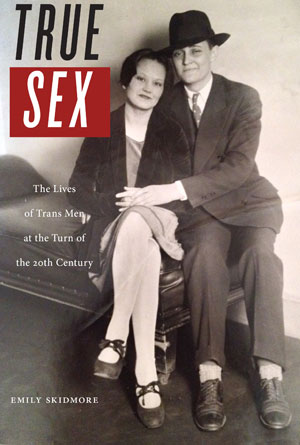
True Sex discusses the lives of eighteen individuals who were assigned female at birth but who lived as male in the decades around the turn of the twentieth century. By looking closely at their lives, I argue that much of what we think we know about queer history in America is not true.
I uncover a past where everyday Americans frequently encountered newspaper stories about “female husbands” and other gender transgressors, and where trans men lived in communities, large and small, throughout the nation. Perhaps most surprising of all, my book reveals that non-metropolitan spaces could be tolerant of trans men, as long as those men conformed to the normative expectations of masculinity. As long as they were economically productive, law-abiding, supportive husbands, and helpful neighbors, their masculinity was valued, not derided. Perhaps unsurprisingly, trans men of color found such tolerance more difficult to come by, and often found their best bet was to try to pass as white in order to attain the privileges of whiteness, including the presumption of innocence.
Much of True Sex challenges what we might assume transgender history looks like. Often, as Americans, we tell ourselves that our history is one of consistent improvement; that while things may have been hard in the past, they are always getting better (e.g., while slavery exists as a blight on our nation’s past, it was followed by Emancipation, and eventually Civil Rights). Given this frame of reference, we might expect that transgender people in the past experienced much worse treatment than they receive today. Yet, my book reveals many cases of trans men who were able to find tolerance instead of condemnation.
One such example is the case of George Green. Green was assigned female at birth in Ireland around 1833. He emigrated to the United States in 1865, and two years later, married a young woman in Erie, Pennsylvania. The pair moved East, and finally settled in the rural town of Ettrick, Virginia, where George worked as a farm hand. The couple was well-respected in the community—a community that appeared genuinely shocked when, after George died suddenly in 1902, neighbors discovered the body lacked the traditional markers of masculine anatomy. However, their shock did not translate into condemnation, and George’s life was positively memorialized in local newspapers. He was celebrated for having been a hard worker, a kind husband, and generous neighbor. In addition, his funeral was held in the local Catholic Church, and his body was buried in the parish cemetery—two actions which attest to the fact that the people of Ettrick were willing to stand by their queer neighbor in life and in death.
Green’s story, and the stories of the other trans men in my book, force us to confront the progressive narrative of history, and think more critically about transphobia that exists in present-day America.
For a long time, histories of the LGBT community were often based in urban areas. George Chauncey’s Gay New York, published in 1994, is an early example of this. Chauncey’s work was path-breaking in the field of LGBT history, and influenced many other historians who followed in his footsteps. Many borrowed his approach of writing a case study about one particular city. There have since been great books on the queer communities of Philadelphia, San Francisco, among others, and another book, on Miami, Welcome to Fairyland by Julio Capo Jr., will be published soon.
This focus on urban areas, while resulting in the publication of many great books, has also resulted in relatively scant attention being paid to queer histories in non-metropolitan areas. This tendency is what gender studies scholar Jack Halberstam has coined “metronormativity.” My book is part of an emergent field of scholarship in queer studies that challenges metronormativity, and looks at queer history beyond large cities. I think such work is especially important in today’s political climate, wherein anti-transgender legislation is often justified in non-metropolitan areas by calling on images of rural America as untainted by the queerness purportedly endemic in large cities. True Sex pulls the rug out from under that argument by showing that trans men have just as much claim to rural histories as do ranchers, farmers, and miners. In fact, many trans men worked in these professions.
The relative silence around histories of gender transgression in rural areas is part of what drew me to this project. I began this research in graduate school after stumbling upon a series of photographs within a digital collection of images from the Old West on an archive’s website. In the photographs were a group of women, about eight of them, posing in men’s clothing. In one image, they were smiling and laughing, while posing with beers and cigars while dressed in black suits and ties. In another image, they were outside, posing by a mountain stream, this time with top hats. These images captivated me, because they suggested a history that has been hidden from view: a history of individuals in rural spaces, experimenting with gender and challenging proscribed gender roles. Ultimately, stumbling upon those images ten years ago is what led to the research that resulted in True Sex.
At the end of chapter one, I discuss one of my very favorite primary sources in the entire book: an editorial published in the New York Times in late 1883, titled “Female Husbands.” If a casual reader approached my book, I would love for them to open to this editorial (and my discussion of it) because it reveals a great deal about the surprising ways in which gender and sexuality were understood and debated in the 1880s. To give you a taste of it, the editorial opens:
If Mrs. Dubois chose to marry a woman, whose business was it? Such a marriage concerns the general public less than the normal sort of marriage, since it does not involve the promise and potency of children. It has been well established that if a woman chooses to wear trousers she has a right to wear them, and no one will venture to deny the right of any two women to live together if they prefer one another to solitude. Why, then, has not Mrs. Dubois the right to live with another woman who wears lawful trousers, and why should so much indignation be lavished upon Mrs. Dubois’s female husband?
There are many women who, if they had the opportunity, would select other women as husbands rather than marry men. The women who regard men as dull, tiresome creatures, incapable of understanding women, would find sympathy and pleasure in the society of female husbands. (“Female Husbands,” The New York Times, November 4, 1883.)
While up to this point, the anonymously published editorial appears to be an earnest endorsement of same-sex marriage, it quickly takes a satirical turn:
The marriage of women would solve the problem which renders wretched the superfluous women of New England. Those unhappy women cannot marry because there are not enough men in New England to be divided fairly among them. The New England men, to a large extent, abstain from marrying their fellow New England women, and prefer to seek wives in other states. If half of these neglected women were to put on trousers and marry the other half, the painful spectacle of a hundred thousand lonely spinsters would forever disappear. The female husbands and their wives could read Emerson’s essays to each other, and thus completely satisfy the wildest longings of the female New England heart. What more could a New England spinster desire than a husband who never smokes, swears, or slams the door; who keeps his clothes in order, and does not stay out of the house until late at night, and who reads Emerson, understands the nature of women, and can discuss feminine dress with intelligence and appreciation? (Ibid.)
I just love this source, as it is so provocative in what it suggests about the ways in which Americans discussed gender and sexuality in the 1880s. While it is no doubt satirical, I wonder about the multiple ways in which contemporary readers responded and interpreted its words. Some, no doubt, saw logic in the author’s argument for same-sex marriage—and some, perhaps, were themselves engaged in queer relationships and felt legitimated by these words. So, if a prospective reader encountered my book at a book store, I would love for them to open to this passage, as it is a great example of what my book as a whole does: it suggests a past that is much queerer than we commonly anticipate.
Ultimately, I think the book suggests that the United States has a long history of gender transgression. This insight should push us to be critical of the idea that transgender issues are new, and that transgender people pose a threat to the nation. My book provides many examples of the ways in which trans men have contributed to, and fought for, their nation. I also hope that it inspires others to do further research in transgender history, because there is still so much we don’t know. True Sex just begins to scratch the surface, I hope future scholars continue to dig deeper to further our understandings of America’s long and rich history of gender transgression.


Emily Skidmore is an Assistant Professor of History at Texas Tech, where she teaches courses on the history of gender and sexuality in the United States. In addition to True Sex, her work has appeared in Feminist Studies and GLQ: A Journal of Lesbian and Gay Studies, and she has been featured on the NPR podcast, “Backstory.”